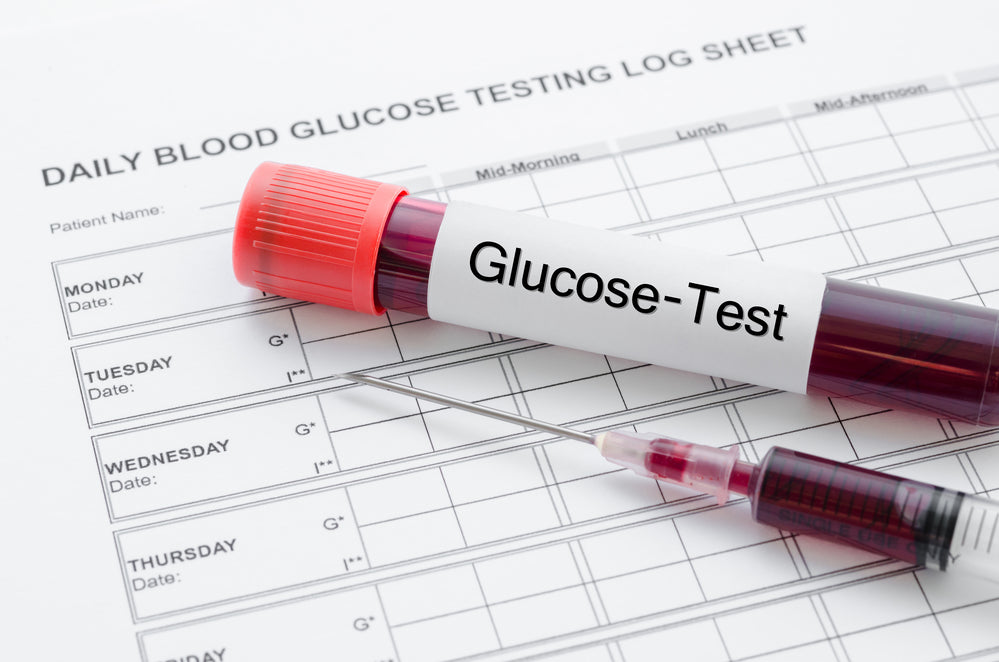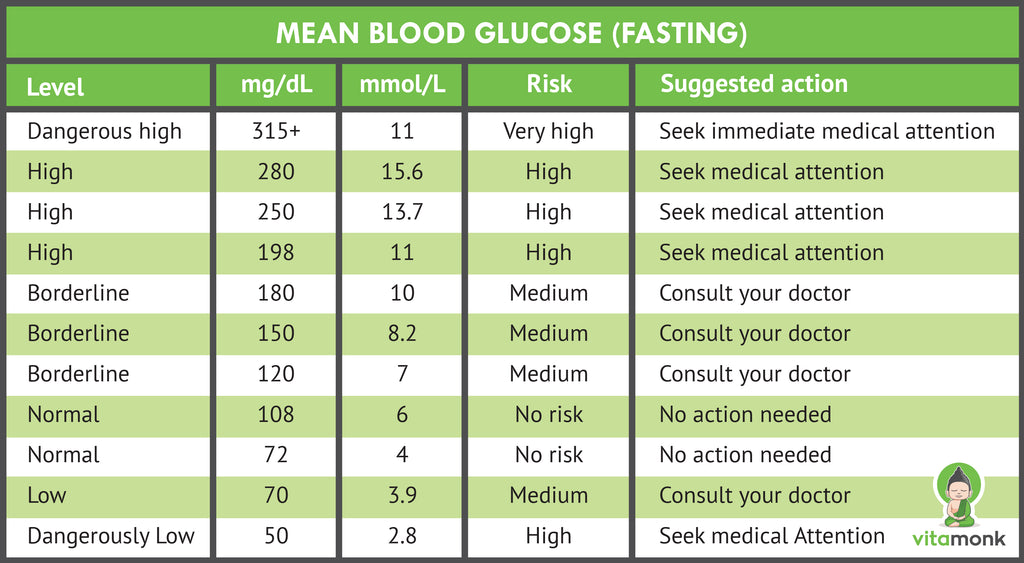A Simple Blood Sugar Level Guide - Charts, Measurements, Levels, and Management
Blood Sugar Levels Chart

An easy to follow chart for blood sugar levels
--------------------------------------------------------
*Update*
We actually got tired of all the junk products promising to help blood sugar levels, so we set out and made one ourselves, based on science, and that we believe in. If you're interested, you can grab our our blood sugar support supplement here.
Thanks! The Vitamonk Team
--------------------------------------------------------
We’ve read a lot of confusing and even misleading information about blood sugar levels on the web, so we thought we’d set the record straight with a simple, straightforward guide to your blood sugar and how to manage it.
If you’ve been feeling fatigued, dizzy, or nervous lately, it could be because your glucose levels are off. This article will set you on the right tracking to eating, exercising, and maintaining healthy levels and feeling GREAT.
“Blood sugar? No thanks, my dental insurance doesn’t cover cavities” - Dracula (1897)
What is Your Blood Sugar?

Your blood sugar, or glucose (we cover that next), is the “sugar” content found in your blood. It’s a vital source of energy for your organs and muscles.
Think of it like the fuel in your gas tank. Without gas pumping through your car’s system, you’re going to slow down and eventually come to a halt. Same with blood sugar, which is why people with low blood sugar often feel tired.
You get it from the foods that you eat, and then a complex system involving the pancreas, liver, and small intestine regulates its distribution throughout your body. Your body is SUPER picky and only likes this stuff up to a certain level.
We’ll get to glucose levels in a minute, but let’s cover what glucose is first….
What’s the Difference Between Blood Sugar and Glucose?

Blood sugar and glucose are used interchangeably, but it’s important to understand that glucose isn’t really “sugar” as you know it. There aren’t granular white cubes flowing in your veins and arteries.
There are many different forms of sugar, including:
When bite into a delicious apple, guzzle a glass of milk, or down an IPA, the sugars you ingest are converted into glucose by your body.
Key Takeaway: Glucose is what your body converts sugars into and uses for energy. When people say “blood sugar”, they really mean glucose. Don’t be that guy that corrects people. You won’t have friends.
What Are the Symptoms of Low Blood Sugar?

The symptoms of low blood sugar include:
- Weakness
- Fatigue
- Dizziness
- Feeling anxious
- Blurred vision
More severe symptoms can range from confusion and inability to concentrate, to seizure or stroke.
Of course, this is not an exhaustive list and you should always consult a physician. However, if you’re constantly feeling fatigued or weak, and the rest of your life is in order, it’s definitely something to consider.
NOTE - Extreme hunger is a bad sign: If you’re ravenously hungry even though you’ve been eating like horse, your body is trying to tell you “I NEED MORE GLUCOSE”. Get checked out ASAP.
Did you know?: High blood sugar, or hyperglycemia, also exists and is characterized by a rapid heartbeat, insatiable thirst, frequent trips to the bathroom for #1, and blurred vision. Having your blood sugar too high is also dangerous.
How to Measure Your Blood Sugar

“I can’t wait to stab myself today” - Nobody (dawn of time - present day)
Blood glucose is measured using a kind of confusing system that exists out of our stubbornness to change outdated systems (or to keep doctors and scientists in business).
In the USA, it’s measured using milligrams per deciliter (mg/dl).
In the UK and commonwealth countries, it’s measured using millimoles per liter (mmol/L). You can adjust a study done with the British system to the American system by multiplying the British numbers by 18.
Hope that’s all making sense….
Now comes the fun part: NEEDLES.
If you want to measure your blood glucose, you either need to prick your finger and measure it using a neat little measuring stick and meter or get a continuous monitoring device inserted under your skin. The second option might be a little too much unless you have a serious condition.
What Are Normal Levels of Blood Sugar?

Normal levels of blood sugar for non-diabetics range from 70-130 mg throughout the day. They are at their lowest (70-90 mg) in the morning and before meals, and at their highest about an hour after meals.
It’s normal to have a blood sugar level of 130 or higher an hour after meals. Obviously, your blood sugar levels will decrease gradually as your last meal gets further and further in the rearview mirror.
What Levels of Blood Sugar Are Dangerous?
Human bodies are wonderfully complex organisms, sometimes to a fault. It’s really hard to say exactly what levels of blood sugar are dangerous unless they are really dangerous.
What we mean by that is healthy individuals can have glucose levels ranging from 60ish to about 140. Things start to get bad when you exceed these number, but symptoms might not become apparent until you’ve reached really dangerous territory. That’s why it’s important to measure.
How Does Diabetes Affect Blood Sugar?

Diabetes is a disease where your body doesn’t produce insulin or doesn’t utilize it well. Insulin is the hormone that pulls glucose from the blood into your cells to be used for energy. Without it, your blood sugar levels will be TOO HIGH, since none of it is being utilized by your body.
The disease has 2 main forms:
There is no cure for diabetes, but it can be managed. Your goal should be to keep your blood sugar levels as close to regular levels as possible. The American Diabetes Association recommends 80-130 mg pre-meal and below 180 mg/dl post-meal for non-pregnant people living with diabetes [1].
Tip: Eat foods with a Low Glycemic Load to Lower Your Risk of Diabetes

Glycemic load is a scientific way of measuring a food’s digestible carbs (carbs excluding fiber). This is contrast to glycemic index, which ONLY measures a food’s effect on your blood sugar levels. There is heavy scientific evidence that foods with low glycemic index reduce risk of type-2 diabetes [2].
These foods include:
Avoid high glycemic load foods such as french fries (NOOOO!), sugary drinks, candy bars, and even white rice as much as possible.
FAST FACT - 100 MILLION Americans are now living with diabetes or prediabetes according to the CDC [3]. That’s a staggering number.
If you’re healthy now, your health is in your own hands. You can take steps to mitigate risks. These include proper diet, exercise, and even filling in the gaps of your diet with health supplements.
How to Manage Diabetes
Diabetes is not a death sentence. There are million of people living happy, healthy lives with type-2, and even type-1 diabetes. You just need to be more careful, listen to doctor’s advice, and take your medications.
Yes, that means avoiding loading up your popcorn bag with M&Ms and going to town every time you go to the movies.
Here are a few more tips that will help you lead a better life with diabetes:
The Best Blood Sugar Supplements: How Supplementation Can Help

Supplements for blood sugar can help fill in the gaps of your diet and promote your overall health. Some supplements are even specially formulated to help regulate blood sugar levels and provide other healthy benefits like weight loss and muscle building.
The best way to keep regulate blood sugar is to eat a healthy, well-balanced diet.
Personally, we struggle to always stick to a healthy diet, especially since the world is full of so many unhealthy options. That’s where a clean, all-in-one supplement comes in.
There are so many blood sugar supplements. It’s best to stick with only the most potent ones
One issue we found with blood sugar supplements is that there are just too many. When we first started researching, it seemed like everything could “potentially” promote healthy blood sugar levels.
Through rigorous researching and testing, we discovered a few ingredients that actually proved to help. Berberine, rock lotus, bitter melon, banaba leaf, and a few others were the most effective.
Getting all of these potent ingredients in one capsule allowed us to optimize our nutrient intake. Instead of just taking shots in the dark and hoping you get enough of each substance, you can be 100% sure you’re getting all of the most powerful blood sugar supplements PLUS extra benefits like antioxidants. Just one capsule 3 times daily is all you need.
It works for us, so it could work for you too!
References
[1] http://www.diabetes.org/living-with-diabetes/treatment-and-care/blood-glucose-control/checking-your-blood-glucose.html
[2] http://www.diabetes.org/food-and-fitness/food/what-can-i-eat/understanding-carbohydrates/glycemic-index-and-diabetes.html
[3] https://www.ncbi.nlm.nih.gov/pubmed/23364021
[4] http://www.diabetes.org/food-and-fitness/food/what-can-i-eat/understanding-carbohydrates/glycemic-index-and-diabetes.html
Updated January 24, 2020